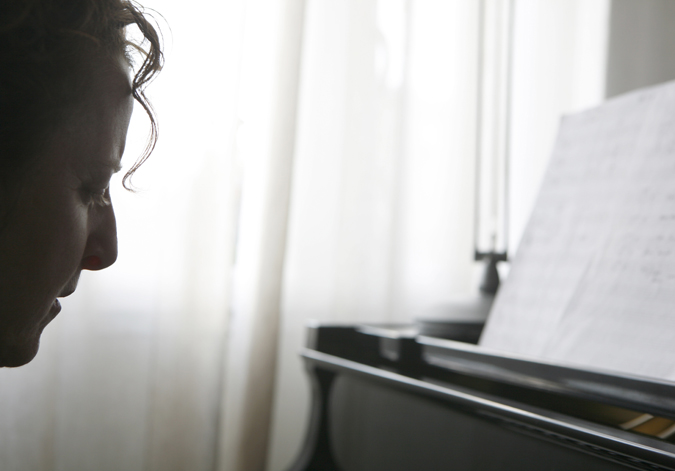
Myra Melford is one of the most exciting musicians working in any genre, and though she’s most frequently associated with the more avant garde circles of jazz, sometimes it seems as if she’s working in every genre. Drawing from influences as diverse as the blues of her native Chicago and the North Indian harmonium music she studied as a Fulbright Scholar in 2000, her music defies even the bravest attempts at categorization.
January will see the release of The Whole Tree Gone (Firehouse 12 Records), her first outing as a bandleader since the 2006 album The Image of Your Body, both of which recorded with her elastic and versatile ensemble Be Bread, consisting of Cuong Vu on trumpet, Ben Goldberg on clarinet, guitarists Brandon Ross and StomuTakeishi and drummer Matt Wilson. Melford talks to At Length about her new record, and pushing the boundaries of geography, genre and gender in the information age.
Click the player below to stream a track from Melford’s new record. Depending on your internet connection, the song may take a minute to load.
Myra Melford’s Be Bread – “The Whole Tree Gone”
At Length: This record came as a bit of a surprise to me, because I was expecting more of the electric touches that you began to explore on The Image of Your Body, your first record with Be Bread. Why did you move away from that on this album?
Myra Melford: It just seemed that the music I wrote seemed to be more appropriate for an acoustic ensemble. Sometimes I don’t know that. I can have a certain idea about who I’m writing for and what I want to happen with it, and then when I actually start playing the music, I feel it would sound better in a slightly different setting. So in this case, I decided that I liked having everything acoustic as a contrast to the last book of music.
AL: These recordings are a few years old, are they not?
MM: The recordings aren’t old, but the compositions were written a few years ago. Everything was recorded just a year ago. So all of those are recent performances. But it’s music that I wrote for a Chamber Music of America grant in 2004. So I’ve had many years to perform the music, and try it with different people, and finally got to record it with this group this last December.
AL: Has the music changed a lot during that time period, playing with different musicians?
MM: Yeah, I think every time I play it I learn something new about it, but you know the compositions – the actual composed material – don’t change very much. What can change is, obviously, the arrangement, depending on what players and what instruments are being used. The other thing that tends to change a lot is the improvisation, depending on who’s improvising it. And the better I get to know the music, the more free I feel with the material to try a lot of different approaches to improvising on it. And that’s the really fun part – to see how different it can be and still be the same composition.
AL: That seems akin to one of the fundamental principles of a lot of avant garde art: Once you master the basics of pure formalism, you can feel free to experiment.
MM: Well, I think that’s true and at the same time I think you could argue that as you’re getting to know the material and you’re experimenting and exploring, you’re at once mastering and also learning what that material is. So, I wouldn’t discount all the experimenting and insights you get while you’re still learning the music, if you know what I mean. That whole process is important, especially for me. While I have colleagues who I greatly admire who decide what the music is, and they write for a new band, and they play it with that band, and they record it and that’s it. But for me, first of all, I like playing the music in a lot of different contexts, and it’s become part of my creative process to live with the music for a while and discover more and more about what the potential is.
AL: Rock music, and popular music in general, tends to be much more the other way, where you write the composition almost during the recording process.
MM: Right.
AL: But technology has changed the context of recording and putting out product, so that even in rock music, bands and artists will post early versions of songs and almost workshop them out online. Have you done any experimenting with that?
MM: You know, I’m pretty bad about trying these new technologies, but I have to say that I do see it changing with my colleagues and peers with all the social networking things. I have a MySpace account which I try very hard to keep updated, but I’m always behind. I do notice that a lot of my “friends” are exploiting it pretty well. And I also have friends who are great about either blogging or sending out a newsletter to their fans about what’s going on. I can see that it’s really appealing and has been quite effective for some of them. We’ll see if I ever get around to doing it. I think it’s happening more and more with the advent of the internet and the demise of the record industry as we know it. I think people are really – partly out of necessity and partly out of creativity – using that kind of networking to good effect with this kind of music. Because yes, you could say I’m a jazz musician, but I’m equally at home in a kind of alternative music scene because I don’t play straight-ahead jazz. It seems like those people on the fringes are the ones that kind of have to look into other ways of reaching fans, because they don’t have access to mainstream venues for that.
AL: When you push past the boundaries of any given genre you suddenly find yourself with a lot of other like-minded people who are doing the same thing in other genres.
MM: Exactly.
AL: Speaking of the internet, a lot of the hallmarks of the information age are things you’ve already been doing. Like pushing between genres, and even between cultures. You’ve done a lot of work in Japan with Satoko Fujii, and of course you’ve done your Fulbright studies in North India, and it seems like you’re ahead of the curve. Do you find more people that you’re working with are getting a more global mindset or are doing more of this collaboration across continents?
MM: Yeah. I think it’s just a natural outgrowth of how much we travel, how easy it is to travel anywhere in the world, and also how easy it is to hear music from anywhere in the world whether you travel or not. The third reason are these social networking things where all of a sudden I’m friends with all of these people in far-flung places that I didn’t even know had listened to my music. So I think for me certainly a lot of it is based on being able to travel, to work with Satoko and certainly what I’ve done in India, but I think I have made similar kinds of connections to people in Europe, like Han Bennink. I’ve just come back from a trip to Europe, where I was in Berlin for a couple of days, and I’m working on a project here at UC Berkeley where I’m trying to amplify the inside of the piano, which is not so easy to do. I met up with a couple pianists, one in Berlin and another in London who are doing similar experiments, and we started exchanging notes and talking about projects. I think it’s just partly my own personality and partly because of travel and being able to hear music from all over, it’s a lot easier to make those connections than it was even twenty years ago.
AL: We mentioned Satoko earlier, who is just one of a number of women that you have collaborated with. Jazz, like a lot of things both in music and without, has tended to be historically dominated by men. You seem to work more frequently with women than the average musician. Is that a conscious choice? Do you feel compelled to nurture younger women in jazz, or make a point to collaborate with other women who are your peers?
MM: Yeah, it’s interesting. If you look at my work historically, I went through a long period of working mostly with men, although early on in my career, in the late ’80s, I worked with a flute player named Marion Brandis, and she and I put on this women’s improvisers festival, where we were celebrating the fact that there were, in fact, a lot of women doing interesting, creative music with improvisation, whether jazz or some other kind of alternative orientation. But when I started getting into writing and playing my own music, I saw myself gravitating towards musicians who I felt best helped me realize that music, and a lot of them happened to be men. And just in recent years, I’ve discovered that there’s all these younger women who are wonderful musicians who I do feel a real affinity with musically, and it’s been really fun to start to work with them, and I think now it is again like it was in the late ’80s. it’s a conscious choice in part, but it’s also that it really makes sense to me musically. The other person I’ve been working with who’s really great is Nicole Mitchell.
AL: I didn’t know that the two of you were collaborating. Are you working as a duo, or part of a larger ensemble?
MM: Well, right now it’s that I’ve been a guest with her ensemble. She wrote a piece, a suite of music for Alice Coltrane a couple of summers ago with me as a guest soloist. That’s been performed now several places around the world, and we’ve talked about doing a duo or something like that which hasn’t materialized yet, but I’m hoping it will at some point.
AL: This new record strikes me as very warmly conversational. There are solos, but they feel tightly and organically connected to the composed material, all the players acting together toward a common goal. And I notice that you’ve been involved lately with a couple of projects that are leaderless ensembles. How do you interpret the role of a bandleader in a jazz ensemble, and has that changed for you over the years?
MM: Well, I’ve always really welcomed playing with musicians who are comfortable collaborating even if they’re “side people.” I’ve always welcomed the input of the people in my band. Part of the reason I hired them is because of their personality and their approach to things, and I’ve always been more open to that than some band leaders would be. I think also, obviously, I have a lot more experience now than when I was younger, and I would say that of the two collective projects I’ve done most recently – Trio M and the duo with Marty – have been very collaborative, especially Trio M and the way that group has been approaching improvisation. We certainly still solo and have times where we’re featuring one or the other of us, but a lot more of the time we don’t even prearrange any of that. If someone emerges as the soloist for a while, great, if they pop up for a minute and someone else takes over… it’s extremely conversational, to the point where we’re discovering what the arrangement of the music is while it’s evolving. Obviously it takes a lot of listening and a lot of communicating in a way that is conversational, and I’m sure that informs a lot of the way I work with my own band now.
AL: It certainly feels very ego-less when you listen to this record. You feel like you’re listening to a really integrated unit.
MM: That’s nice to hear.
AL: You’re currently on tour in California. Are you planning on doing any other touring when the record comes out?
MM: I was planning on doing two tours in January: a long weekend on the East Coast and a long weekend on the West Coast. The East Coast dates will have to be postponed, but we still will be playing several dates in California: at the Freight & Salvage, which is a a club in Berkeley on the 27th; on the 28th we’re going to Kuumbwa Jazz in Santa Cruz; the 29th and the 30th will be at the Redwood Jazz Alliance in Arcata.
AL: I wanted to ask you one other question that I find really interesting. You frequently draw upon work from other forms of artistic expression – I’m thinking about the song “Frank Gehry Goes West to Rest,” your work with poetry, and the piece on this record, “Moon Bird” for the Miro Sculptue at MoMA. How do these other works, visual art and literature, translate for you into a piece of music? What’s that process like?
MM: I have to say that for me it’s very intuitive – very little of it is intellectual. So it’s not like I’m trying to make this direct, very literal sort of translation. It’s more that when I’m moved by another work of art of whatever medium, I start to hear that or feel that musically, and that’s the first point. And the second point is that I rely on my standard approach to composing, which has a lot of variability in it, but I’ll start to work with material that somehow seems related to that work of art and I’ll develop it over a period of time. Then I’ll start to put the elements together, again referencing that work of art, but as I say, it’s very intuitive and has a lot to do with being inspired by a work of art in another medium and then translating those feelings or insights or whatever I get from that work of art into a musical form.
AL: Have you ever done a work of art in collaborating with a visual artist or a poet where the two of you work to create parallel works of art at the same time?
MM: I’ve done several projects like that. The biggest multimedia thing that I’ve worked on is a piece called Knock on the Sky that was a collaboration with two Butoh-trained dancers – Dawn Saito, who’s in New York and Oguri who’s in LA – and an archtiect friend of mine [Michael Haberz] who’s from Graz, Austria, and a colleague of his who’s a videographer. So we had live video in this architectural setting, mixing musicians who have worked with me (Cuong and Stomu – both from this record) and the two dancers. And there was a highly theatrical component to the work as well. It was based on Kobo Abe’s Woman in the Dunes, which was also made into a fantastic movie in Japan with a score by [Toru] Takemitsu. So that was our starting point. In this case, yes, we were all working off the same ideas, but going apart and developing our individual components and then coming back and putting them together and seeing how we needed to revise things, and going away and coming back again. So that was a fantastic process and the most ambitious multimedia work I’ve done. But I also used to work with a poet named Ruben Jackson when I was in New York – he’s at the Smithsonian in DC – and in that case it was more writing music that I felt worked with his poetry, so it wasn’t quite as collaborative in the same way. I’ve also worked with several other dancers, and done a lot of improvising with Oguri, this dancer in LA whom I mentioned. We get together and decide very little and do these free improvisations. But I really love working with other media for sure. Right now, I’m working on a project based on the drawings of an artist friend of mine who is based up in San Fransisco named Don Reich. I got a commission to write some music for his paintings, which will then be performed in an installation of his work at the Crocker Museum in Sacremento next year.
AL: Thank you so much for giving us your time today.
MM: Thank you so much.

![Monument for Inger Christensen. Photo by David Stjernholm. Featured image for [o] by Kristi Maxwell.](https://atlengthmag.com/wp-content/uploads/2025/06/Monument-for-Inger-Christensen_Kaare-Golles_002_Photo-by-David-Stjernholm-1280x914-1.jpg)
